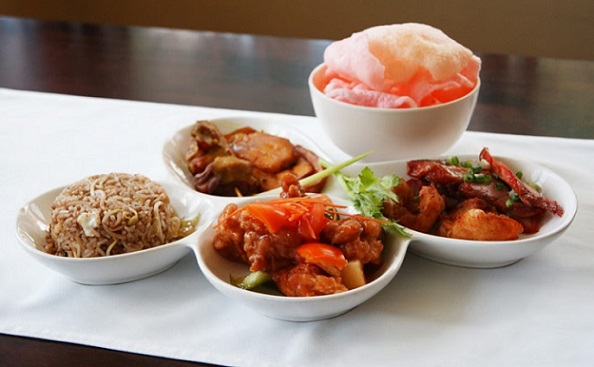[Many thanks to Peter Jordens for bringing this item to our attention.] The full title of this article by Kaila Yu (South China Morning Post) is “‘United Nations seafood, Four Seasons chop suey’: Chinese food in Curaçao a fusion of Dutch and Caribbean influences.” Yu writes that “although Chinese make up only 1 per cent of the Caribbean island’s population, there are over 250 Chinese restaurants, but most don’t serve what you might think.” She adds, “From Spanish-style pork chops to nasi goreng, dishes take influence from the Caribbean to Indonesia, and reflect the ingenuity of the island’s Chinese migrants.” Here are more excerpts:
A pair of metallic gold dragons peer down from the red wall of a bustling dining room, as families enjoy generous plates of crisp roast pork, wok-smoked fried rice and seafood chow mein.
It appears to be a typical Chinese restaurant, but if you look closely at the menu you’ll find dishes such as grilled conch, tomato stewed shrimp and nasi goreng.
At the Lam Yuen Restaurant, diners enjoy a Caribbean riff on Chinese food. One of the oldest Chinese restaurants on Curacao, Lam Yuen is in a shopping precinct on bustling Kaya C. Winkel Street, in the Dutch-ruled Caribbean island’s capital, Willemstad. Affixed to its red and grey exterior, the restaurant’s sign is crowned by a parakeet-green Presidente beer logo that is lit up in neon red and blue at night.
Although Chinese people make up only about 1.1 per cent of the 150,000 or so population of Curacao, there are more than 250 Chinese restaurants on the 444 sq km (170 square mile) island, accordingly to Lam Yuen’s owner, Benson Lam. However, only a handful serve traditional Cantonese cuisine and dim sum.
The vast majority offer a Dutch Caribbean take on Chinese food (Curacao is an autonomous constituent country of the Netherlands), and these restaurants tell the story of Chinese entrepreneurship and immigration to the island.
“My family came to Curacao in 1944, during World War II. They were part of a wave of Chinese migration, mostly from the Guangdong region [in southern China],” explains Lam, who is also president of the Curacao Chinese Business Association. [. . .]
The Rose Garden Curacao restaurant was also a product of hopeful immigrants. It is on tree-dotted Oude Caracasbaaiweg Street, in the Salinja neighbourhood of Willemstad, in a red building with a double-pitched Dutch-colonial-style roof. Half its frontage is painted pale pink, perhaps in a nod to Willemstad’s famous candy-coloured buildings.
“My grandparents migrated in the 1960s,” says Andrew Ng, son of the owners, Italia and Jimmy Ng. “Back then, China was quite poor and many Chinese were immigrating, looking for better opportunities for their families.”
The first significant wave of Chinese immigration to the Caribbean occurred between the 1850s and ’60s when around 18,000 indentured workers landed, mostly in British Guiana, Trinidad and Jamaica, and then spread to other Caribbean islands, including Curacao.
After completing their contracts, some stayed and worked as cooks; a few opened their own restaurants. As a result, “our Chinese dishes are adapted to suit the tastes of the locals”, according to Ng. “It’s the same concept as American Chinese food.”
Indonesian flavours are also an influence. Curacao’s Chinese restaurants often offer dishes such as nasi goreng (a dish of fried rice topped with a fried egg, said to have been created by the Chinese diaspora in Indonesia), saté and kroepoek – shrimp crisps.
Arguably the most popular Dutch Caribbean Chinese dish is saté ku batata – satay and potatoes. This affordable meal consists of a plate of steaming rice topped with one or two kebab sticks of chicken or pork, a generous helping of thick-cut fried potatoes and a shower of satay sauce. [. . .]
For full article, see https://www.scmp.com/lifestyle/travel-leisure/article/3202930/united-nations-seafood-four-seasons-chop-suey-chinese-food-curacao-fusion-dutch-and-caribbean
[Photo: Rose Garden: Dishes at Rose Garden restaurant in Curacao that reflect the varying influences on the island’s Chinese cuisine.]


One thought on “‘United Nations seafood, Four Seasons chop suey’: Chinese food in Curaçao…”